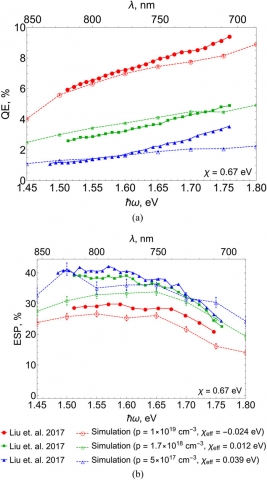Monte Carlo modeling of spin-polarized photoemission from p-doped bulk GaAs
GaAs is a bright electron source. Moreover, GaAs and GaAs-based photocathodes is the only existing technology that can deliver stringent demands of high spin polarization and high beam currents simultaneously as required by various high-energy and nuclear-physics experiments at leading accelerator facilities, including SLAC, Jefferson Lab’s CEBAF, and future BNL’s EIC. Photoemissive properties of GaAs as well as its spin relaxation mechanisms have become a subject of numerous studies. Nevertheless, the question of why methods and techniques, commonly used to increase quantum efficiency (QE), cause spin depolarization, and vice versa, remains open. In this work we provide first-to-date Monte Carlo investigation of spin-polarized photoemission from bulk GaAs. We study in detail the influence of the photoexcitation energy, doping density, and electron affinity level on QE and electron spin polarization (ESP) simultaneously. We show that the behavior of both QE and ESP at room temperature can be fully explained by the bulk relaxation mechanisms and the time which electrons spend in the material before being emitted.
This research advances CBB Beam Production Theme’s goal to identifies fundamental mechanisms which limit the performance of GaAs electron sources. Our results for various transport and photoemission characteristics are in good agreement with available experimental data in a wide range of photoexcitation energies and doping densities. Therefore, this work creates a paradigm for future studies of photoemission characteristics from other materials and more complex geometries. Further work is also underway to modify the model in order to study laser induced heating effects in GaAs.
Reference:
O. Chubenko, S. Karkare, D. A. Dimitrov, J. K. Bae, L. Cultrera, I. Bazarov, and A. Afanasev, “Monte Carlo modeling of spin-polarized photoemission from p-doped bulk GaAs,” Journal of Applied Physics, vol. 130, no. 6, p. 063101, Aug. 2021, doi: 10.1063/5.0060151.

